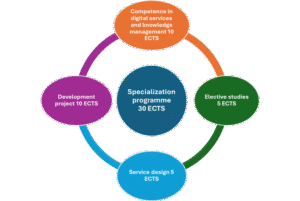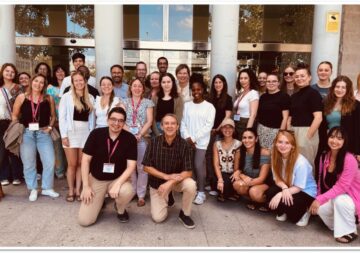
Since the reform of the Wellbeing Services Counties in Finland in 2023, the primary goals have been to ensure equal access to services, reduce inequalities, and manage the rising costs of service provision. Achieving these goals requires competencies, such as multiprofessional teamwork, utilization of technological solutions, service system expertise, and advanced problem-solving skills. A specialization education programme was developed collaboratively by 14 Finnish universities of applied sciences to support Counties’ needs. This qualitative study explores the digital solutions the participants in the programme developed. They applied service design methods in their development projects, resulting in concrete, digital-related solutions tailored to organizational needs. The findings indicate that the specialization training effectively promoted digitalization objectives and contributed new competencies and meaningful innovations to the social and healthcare sector.
Authors: Annamaija Id-Korhonen and Hannele Tiittanen
Finland has undergone a major reform in organizing health care, social welfare, and rescue services for the population, and since 2023 the responsibility for providing the services has been under 21 Wellbeing Services Counties. The challenge for the Counties was to ensure equal services, reduce inequalities and curb the growth in costs of the services (Saario 2025). In response to these challenges, the services have been closely integrated, and service paths for the clients needed to cross the former boundaries of these two sectors. Also, new digital tools and services have been put into use, and citizens’ responsibility for their health and well-being is emphasized. (Kouri et al. 2023.) As digital services are the primary choice of services in Wellbeing Services Counties in Finland when appropriate, clients need to be well informed. The better use of information and advanced technological solutions are also targeted to reduce the workload of healthcare and social welfare personnel. (Ministry of Social Affairs and Health 2024.)
When integrating social and healthcare services multi-professional and multidisciplinary teamwork and cooperation competencies are prioritized and connected especially to the client perspective, ethical and digital competencies, and service system competence. These competencies are suggested to be emphasized in social and healthcare education and professionals’ continuing professional education (Sosiaali ja terveysministeriö 2024). Digital competencies are more than technical skills, they are multicomponent entities with different knowledge, skills, and psychological competence requirements (Longhini et al 2022). Align with technological development, problem-solving skills, creativity, innovation, flexibility, and cooperation are becoming increasingly important (Opetushallitus 2019). Also, the World Economic Forum (2025) report highlights general competencies and especially the importance of network, AI, and big data competencies needed in various fields in working life. Finland is advanced in public services digitalization; however, to foster digital innovations that provide value for people and organizations still requires working life professionals’ competence developments (Finnish Government 2022; Pennanen et al. 2023).
In Finnish social and healthcare education, digital competencies have already been recognized as a part of the professional competence descriptions (e.g. Silén-Lipponen & Korhonen 2020). However, there are still relatively many professionals who have not received IT-related training during their professional studies, and their ability to benefit from digital possibilities is still limited (Tolonen & Värri 2017). A study by Navarro-Martinez et al. (2023) has shown that the same challenge exists elsewhere in Europe, for example, only 20% of Spanish nurses have had in-service training in health technology. Kaihanen et al. (2021) consider it essential that teaching information technology should be invested in basic professional education and on-the-job training, as working with digital platforms takes a significant amount of time. Also, a lack of needed digital competencies seems to add stress for professionals related to digital information systems.
The structure and implementation of the national specialization programme
In Finland, a specialization education in higher education is a form of continuous education that combines the competence needs of working life and integrates the research and development dimension to the studies. Specialization courses offer flexible opportunities to develop and update skills needed in Finnish working life. (Kallunki & Seppälä 2016; Opetus- ja kulttuuriministeriö 2019.) In response to the competence needs of digitalization in social and healthcare, nationwide continuing education training was developed, and it was organized as specialization education.
The developed continuous education training, Multidisciplinary Competencies in Digital Health and Social Care Services (30 ECTS, 800 hours) was created collaboratively with 14 universities of applied sciences across Finland in a project called UUDO (UUDO-project 2020). Over two implemented training rounds, nearly 250 social and healthcare professionals from different parts of Finland enhanced their digital skills through this training. Participants gained expertise in developing social and healthcare services’ digital ecosystems, and proficiency in managing service design across disciplines. Upon the training’s completion, participants were equipped to undertake complex planning and development tasks in multidisciplinary digital health and social care services.
The program comprised four modules (Figure 1). The ‘Expert of Digital Services and Information Management in Social and Healthcare Services’ module focused on client-oriented competencies, online interactions, and ethical considerations. It also covered information and knowledge management in the sector. The ‘Service Design’ module introduced service design processes and tools (Sirviö et al. 2023, 44), followed by practical application in the ‘Workplace-oriented Development Project’, emphasizing problem-solving and collaboration skills (Id-Korhonen et al. 2023, 46). Elective studies allowed participants to deepen their digital services competence.

Figure 1. Structure of the continuous education training Multidisciplinary Competencies in Digital Health and Social Care Services. (Figure: Annamaija Id-Korhonen & Hannele Tiittanen)
The training was implemented online, which offered flexibility for professionals to study alongside their work commitments. Online meetings facilitated knowledge exchange, and forums provided platforms for discussion and insight sharing. The online approach fostered teamwork among participants nationwide, facilitated seminar work, and broadened understanding of digital social and healthcare across different regions of Finland. Online working was especially beneficial when professionals worked on their development projects, finding solutions to organizations´ digital challenges, and developing client-centered digital services. This article describes the developed digital-related solutions for participants’ organizations in continuous education training.
Material and method
The approach of the study was qualitative and was focused on producing information that promotes solutions for practical questions (Flick 2007). The study aimed to describe digital-related solutions for social and healthcare organizations developed during the second implementation of continuous education training during 2022-2023. The specific research task was: What kind of digital-related solutions did social, and healthcare professionals develop for social and healthcare organizations during continuous education training?
The research data in this study consisted of 26 development projects with digital-related solutions, published as two-page descriptions in the project publication (Ahonen et al. 2023). Altogether, 94 social and healthcare professionals from different Wellbeing Counties throughout Finland developed 34 digital-related solutions, but 26 were published in the project publication and analyzed. The descriptions analyzed were mainly targeted for hospitals and social services, but also for social and healthcare associations, companies, and educational institutions.
Social and healthcare organizations provided development challenges for professionals to solve in their project work. The challenges were raised from the concrete needs of the organizations. Professionals worked in multidisciplinary project teams, followed the service design process, and used participatory service design tools to develop solutions for the given challenges. Teams followed the service design process, which was divided into three phases. The process started with an understanding phase, aiming to find in-depth knowledge of the customer’s perspectives, needs, and wishes related to the service in question. In the second phase, conceptualization was based on the acquired understanding, and the most important challenges were selected for further development. Also, different solution options were produced. During the last phase, the best ideas and solutions for the given challenges were selected for prototyping and testing. (Stickdorn et al. 2018.)
Inductive theme analysis was used to analyze the project works (Naeem et al. 2023). The project work descriptions were read twice. During the second reading round, the developed solutions were collected and organized into themes. Five themes were created and named: Materials; Services; Operating methods; Communication; and Research. Examples of the produced solutions are presented in the results. However, the target organizations are not mentioned as the study aims to give a more general picture of the types of digital solutions developed during continuous education training.
Results
The produced materials for social and healthcare organizations consisted of handbooks, guidebooks, and tools that systematized new practices or guide processes or the use of digital devices. The materials were developed for specific organizations. However, most of the materials were possible to deliver for wider use for similar social and healthcare organizations. Materials were mainly targeted specifically for social and healthcare customers/patients and professionals. Examples of the target groups were the day hospital coronary angiography patients and nurses who were starting remote video receptions before and after joint replacement surgeries. An example of the created tools was a checklist for identifying customers’ timely service needs to support the guidance work of professionals. Also, a game script was produced for internet-based game to provide contraception information targeted at young men.
Different solutions were developed for promoting services. The theme consisted of digital service paths, process descriptions and visualization, and service concepts’ developments. The service developments were targeted to benefit specific groups of clients. An example of the service path development for a particular group was people with hearing problems and their possibility of remote adjustment of the hearing aid and remote reception. Also, a new concept of an easy digital appointment booking system was developed for people over 65 years old to get their flu vaccinations, and a digital care path process for Marevan patients was described on the Internet site of the Wellbeing Service County.
The theme operating methods consisted of better ways of working as a result of the project works. The changes in working practices were mainly aimed at streamlining the work. As an example, the work in a laboratory was organized to happen more efficiently, and a new operating method was taken into use for simplifying and organizing data collection and storing information.
The communication theme consisted of solutions aimed at developing communication within the organizations, making communication more efficient and less burdensome. An electronic daily management platform in Teams was created and the work community was committed to its use in a polyclinic environment. This increased the flow and accessibility of information and made daily management more efficient. Also, an application was created that made internal communication between professionals more effective and increased professionals’ self-management in daily work. The application was piloted in an acute hospital environment and is suitable to be used more widely in hospital settings.
The research theme consisted of surveys that found out users’ opinions of digital tools or their needs. The surveys were not just producing information, but also how the information was to be used as part of the organizations’ development processes. The survey results helped, for example, to develop more customer-orientated digital services, improve user experiences, and to find suitable application solutions to meet the clients’ identified needs.
Discussion
The development projects and their digital-related solutions under review showed that specialization training effectively promoted digitalization aims and produced solutions for social and healthcare organizations’ needs. With the results, the target organizations have found better ways to communicate internally and work more efficiently; they have got materials for specific needs and have developed client-centered services. In addition, the surveys promoted the target organizations’ services development aims. The service design process forced professionals to collaborate in teams to look at the services from the clients’ perspective. As a nationwide project and shared information, the professionals in different parts of Finland gained improved competencies and tools to develop work practices, adding that the good practices were integrated into use in their organizations. Also, Sanerma et al. (2024) study supports the results of this study. Professionals who participated in the specialization training experienced interactive digital learning tools and webinars supporting collaborative learning and the development of new competencies. They felt that the digital and collaborative learning process enables them to change their attitudes for a more positive direction toward digital services and apply new competencies to the creation of new healthcare and social care services.
After Professional Specialization Education Multidisciplinary Competencies in Digital Health and Social Care Services the self- estimated competences of participants strengthened in all competence areas of the studies. The competence in service design strengthened the most. (Ahonen et al. 2024) Faust et al. (2023) present that as healthcare is a complex system with constant change, new collaborative methods are needed to respond to the challenges that change creates. Social and healthcare professionals have recognized that they need more technological tools and skills to provide digital services in inter- and multi-professional collaboration. (Poitras et al 2023). Digital services in social and healthcare have predominantly received positive feedback from users. However, implementation of the services should still be paid attention to; for example, accessibility and integration of services are still critical issues to develop. (Härkönen et al. 2024; Pennanen et al. 2023.)
Social and healthcare professionals’ ability to collaborate, problem-solve, innovate, and develop daily work has become essential to respond to the changing operational environment. Anvik et al. (2019) study in the elderly care environment shows that working places can be effective places to learn and innovate new practices; however, to succeed, it requires an encouraging and supportive working environment. Also, Parmar et al. (2022) study emphasizes the importance of a positive work culture to promote innovations and flexible training possibilities to take the innovations into use in healthcare. An important notice is that continuous education opportunities support professionals’ intentions to stay in their current work and decrease employee turnover intention, job change, or early retirement (Shiri et al. 2023). Therefore, leaders should also have innovation and adaptation competencies to be able to support the staff, rethink the systems and services currently in use, and lead the change. (Spanos 2024).
Conclusion
The purpose of this study was to describe the developed digital-related solutions for social and healthcare organizations in continuous education training. Social and healthcare professionals gained knowledge and hands-on experience in solving working-life operational challenges and innovating user-centered digital solutions. In addition, professionals’ capacity building benefited organizations in their digitalization aims, improving daily operations and service delivery. Close collaboration between higher education institutions and social and healthcare organizations in the implementation of continuous education training promotes digitalization aims that finally benefit social and healthcare clients receiving better accessibility to services and quality care through advanced digital services with streamlined processes, reduced wait times, and errors. Digital communication channels provide clients with improved interactions and personalized services with social and healthcare providers.
Nationally organized continuous education training provides an opportunity to train professionals from different social and healthcare sectors to learn and innovate together and take good practices into use. Although this study was limited considering the literature review and small data, the results have provided good insight into how national continuous education training organized by 14 higher education institutions benefits professionals’ competence development and how the project work integrated into the studies can promote solutions that help daily work or promote larger developments in organizations. More studies should be done on how higher education institutions’ continuous education programmes are benefiting the development aims of social and healthcare organizations.
References
Ahonen, O., Husman, K., Kultavirta, A., Viljanen, J., Helminen, J., Männistö, M. & Syrjäläinen-Lindberg, M. 2023. Tulevaisuuden sotedigiosaajia kouluttamassa – tarkastelussa joustava & monialainen erikoistumiskoulutus. Laurea-ammattikorkeakoulu. Laurea-julkaisut 214. Cited 18 Mar 2025. Available at https://urn.fi/URN:ISBN:978-951-799-691-4
Ahonen, O. M., Sanerma, P., Rauha, A., Naakka, H., Perälä, S., Paldanius, M. & Heinonen, J. 2024. Self-evaluated competences of multidisciplinary students before and after professional specialisation education in digital social and health care services. Finnish Journal of EHealth and EWelfare. Vol. 16(2), 158-174. Cited 18 Mar 2025. Available at https://doi.org/10.23996/fjhw.143128
Anvik, C., Vedeler, J.S., Wegener, C., Slettebø, Å. & Ødegård, A. 2019. Practice-based learning and innovation in nursing homes. Journal of Workplace Learning. Vol. 32(2), 122-134. Cited 18 Mar 2025. Available at http://doi.org.10.1108/JWL-09-2019-0112
Faust, J., Mager, B. & Massa, C. 2023. Healthcare complexity and the role of service design in complex healthcare systems. In Mario A. Pfannstiel (ed.). Human-Centered Service Design for Healthcare Transformation. Development, Innovation, Change. Cham: Springer. 197-219.
Finnish Government. 2022. Government report: Digital Compass. Helsinki: Finnish Government. Publications of the Finnish Government 2022:72. Cited 20 Mar 2025. Available at http://urn.fi/URN:ISBN:978-952-383-609-9
Flick, U. 2007. Designing Qualitative Research. Los Angeles: SAGE. Cited 15 May 2025. Available at https://doi.org/10.4135/9781849208826.n1
Härkönen, H., Lakoma, S., Verho, A., Torkki, P., Leskelä, R-L., Pennanen, P., Laukka, E. & Jansson, M. 2024. Impact of digital services on healthcare and social welfare: An umbrella review. International Journal of Nursing Studies. Vol. 152. Cited 12 Aug 2025. Available at https://doi.org/10.1016/j.ijnurstu.2024.104692
Id-Korhonen, A., Tiittanen, H., Vuolas, M. & Tiainen, M. 2023. Kehittämistehtävä tuottaa uutta osaamista työelämään. In Ahonen, O., Husman, K., Kultavirta, A., Viljanen, J., Helminen, J., Männistö, M., Syrjäläinen-Lindberg, M. (toim.). Tulevaisuuden sotedigiosaajia kouluttamassa – tarkastelussa joustava & monialainen erikoistumiskoulutus. Laurea-ammattikorkeakoulu. Laurea-julkaisut 214. 46-47. Cited 8 May 2025. Available at https://urn.fi/URN:ISBN:978-951-799-691-4
Kaihlanen, AM., Gluschkoff, K., Laukka, E. & Heponiemi, T. 2021. The information system stress, informatics competence and well-being of newly graduated and experienced nurses: a cross-sectional study. BMC Health Services Research. Vol. 21, 1096. Cited 12 Feb 2025. Available at https://doi.org/10.1186/s12913-021-07132-6
Kallunki, J. & Seppälä, H. 2016. Korkeakoulujen erikoistumiskoulutukset. Käsikirja koulutusten kehittäjille. Cited 5 Mar 2025. Available at https://www.unifi.fi/wp-content/uploads/2019/06/korkeakoulujen_erikoistumiskoulutukset_kasikirja.pdf
Kouri, P., Ahonen, O., Klemola, L. & Reponen, J. 2023. Bridging the gaps of social and health care with the means of eHealth and telemedicine. Finnish Journal of eHealth and eWelfare. Vol. 15(1), 1-3. Cited 12 Feb 2025. Available at https://doi.org/10.23996/fjhw.128496
Longhini J, Rossettini G. & Palese A. 2022. Digital Health Competencies Among Health Care Professionals: Systematic Review. Journal of Medical Internet Research. Vol. 24(8), e36414. Erratum in: Journal of Medical Internet Research. Vol. 24(11), e43721. Cited 20 Mar 2025. Available at https://pmc.ncbi.nlm.nih.gov/articles/PMC9437781/
Ministry of Social Affairs and Health. 2024. Strategy for digitalisation and information management in health care and social welfare. Helsinki: Ministry of Social Affairs and Health. Publications of the Ministry of Social Affairs and Health 2024:1. Cited 20 Mar 2025. Available at http://urn.fi/URN:ISBN:978-952-00-5404-5
Naeem, M., Ozuem, W., Howell, K. & Ranfagni S. 2023. A Step-by-Step Process of Thematic Analysis to Develop a Conceptual Model in Qualitative Research. International Journal of Qualitative Methods. Vol. 22. Cited 15 May 2025. Available at https://doi.org/10.1177/16094069231205789
Navarro-Martinez, O., Igual-García, J. & Traver-Salcedo, V. 2023. Bridging the educational gap in terms of digital competences between healthcare institutions’ demands and professionals’ needs. BMC Nursing. Vol. 22, 144. Cited 7 Apr 2025. Available at https://doi.org/10.1186/s12912-023-01284-y
Opetus- ja kulttuuriministeriö. 2019. Osaaminen ratkaisee. Viitekehyksen laajentamistyöryhmän loppuraportti. Helsinki: Opetus- ja kulttuuriministeriö. Opetus- ja kulttuuriministeriön julkaisuja 2019:3. Cited 20 Mar 2025. Available at http://urn.fi/URN:ISBN:978-952-263-615-7
Opetushallitus. 2019. Osaaminen 2035. Osaamisen ennakointifoorumien ensimmäisiä ennakointituloksia. Opetushallitus. Raportit ja selvitykset 2019:3. Cited 7 Apr 2025. Available at https://www.oph.fi/sites/default/files/documents/osaaminen_2035.pdf
Parmar, J., Sacrey, L. A., Anderson, S., Charles, L., Dobbs, B., McGhan, G., Shapkin, K., Tian, P., & Triscott, J. 2022. Facilitators, barriers and considerations for the implementation of healthcare innovation: A qualitative rapid systematic review. Health & Social Care in the Community. Vol. 30, 856–868. Cited 15 May 2025. Available at https://doi.org/10.1111/hsc.13578
Pennanen, P., Jansson, M., Torkki, P., Harjumaa, M., Pajari, I., Laukka, E., Lakoma, S., Härkönen, H., Verho, A., Martikainen, M., Kouvonen, A. & Leskelä R-L. 2023. Digipalvelujen vaikutukset sosiaali- ja terveydenhuollossa. Helsinki: Valtioneuvoston kanslia. Valtioneuvoston selvitys- ja tutkimustoiminnan julkaisusarja 2023:52. Cited 8 May 2025. Available at https://urn.fi/URN:ISBN:978-952-383-059-2
Poitras, M.E., Couturier, Y., Beaupré, P., Girard, A., Aubry, F., Vaillancourt, V.T., Carrier, J.D., Fortin, L., Racine, J., Morneau, J., Boudreault, A., Cormier, C., Morin, A. & McGraw, M., 2024. Collaborative practice competencies needed for telehealth delivery by health and social care professionals: a scoping review. Journal of Interprofessional Care. Vol. 38(2), 331-345. Cited 18 May 2025. Available at https://doi.org/10.1080/13561820.2023.2213712
Saario, M. 2025. Wellbeing services counties will be responsible for organising health, social and rescue services. Ministry of Social Affairs and Health. Cited 20 Mar 2025. Available at https://stm.fi/en/wellbeing-services-counties
Sanerma, P., Ahonen, O., Rauha, A., Naakka, H., Perälä, S. & Männistö, M. 2024. Interprofessional students’ experiences of specialization education on the design and development of digital health and social care services, Cogent Education. Vol. 11(1). Cited 16 Apr 2025. Available at https://doi.org/10.1080/2331186X.2024.2355382
Shiri, R., El-Metwally, A., Sallinen, M., Pöyry, M., Härmä, M. & Toppinen-Tanner, S. 2023. The Role of Continuing Professional Training or Development in Maintaining Current Employment: A Systematic Review. Healthcare. Vol. 11(21), 2900. Cited 8 Apr 2025. Available at https://doi.org/10.3390/healthcare11212900
Silén-Lipponen, M. & Korhonen, T. 2020. Osaamisen ja arvioinnin yhtenäistäminen sairaanhoitajakoulutuksessa –YleSHarviointi-hanke. Kuopio: Savonia-ammattikorkeakoulu. Savonian julkaisusarja 5/2020. Cited 18 Mar 2025. Available at https://urn.fi/URN:NBN:fi-fe2020111089877
Sirviö, T., Ruotsalainen, A., Vuolas, M., Vaihekoski, A., Rosenqvist, H., Elo, A., Niemistö, R. & Saikkonen, S. 2023. Palvelumuotoilulla parempaa sotea. In Ahonen, O., Husman, K., Kultavirta, A., Viljanen, J., Helminen, J., Männistö, M., Syrjäläinen-Lindberg, M. (toim.). Tulevaisuuden sotedigiosaajia kouluttamassa – tarkastelussa joustava & monialainen erikoistumiskoulutus. Laurea-ammattikorkeakoulu. Laurea-julkaisut 214. 44-45. Cited 8 Apr 2025. Available at https://urn.fi/URN:ISBN:978-951-799-691-4
Sosiaali- ja terveysministeriö. 2024. Sosiaali- ja terveydenhuollon integraation edellyttämä osaaminen. Jaoston raportti. Helsinki: Sosiaali- ja terveysministeriö. Sosiaali- ja terveysministeriön raportteja ja muistiota 2024:2. Cited 4 Sept 2025. Available at https://urn.fi/URN:ISBN:978-952-00-5412-0
Spanos, S., Leask, E., Patel, R., Datyner, M., Loh, E. & Braithwaite, J. 2024. Healthcare leaders navigating complexity: a scoping review of key trends in future roles and competencies. BMC Medical Education. Vol. 24, 720. Cited 7 May 2025. Available at https://doi.org/10.1186/s12909-024-05689-4
Stickdorn, M., Lawrence, A., Hormess, M. E. & Schneider, J. 2018. This is Service Design Doing: Applying Design Thinking in the Real World. Sebastopol, CA: O’Reilly Media Inc.
Tolonen, J. & Värri, A. 2017. Survey of health informatics education in Finland in 2017. Finnish Journal of EHealth and EWelfare. Vol. 9(2-3), 217-231. Cited 18 Mar 2025. Available at https://doi.org/10.23996/fjhw.60999
Uudo. 2020. Uusille urapoluille Digisoteosaamisella. Unpublished project application.
World Economic Forum. 2025. Future of Jobs Report 2025. Insight Report. Cited 20 Mar 2025. Available at https://reports.weforum.org/docs/WEF_Future_of_Jobs_Report_2025.pdf
Authors
Annamaija Id-Korhonen, Senior Lecturer, works at the Faculty of Health Care and Social Services at the LAB University of Applied Sciences. She worked on the UUDO-project as a work package leader and an expert in education.
Hannele Tiittanen, Principal Lecturer, works at the Faculty of Health Care and Social Services at the LAB University of Applied Sciences. She worked on the UUDO-project as an expert in education.
Illustration: https://www.pexels.com/photo/a-person-having-online-check-up-5867189/ (Pexels licence)
Reference to this article
Id-Korhonen, A. & Tiittanen, H. 2025. Upskilling social and health care professionals to innovate digital solutions for Wellbeing Services Counties in Finland. LAB RDI Journal. Cited and date of citation. Available at https://www.labopen.fi/en/lab-rdi-journal/upskilling-social-and-health-care-professionals-to-innovate-digital-solutions-for-wellbeing-services-counties-in-finland/






